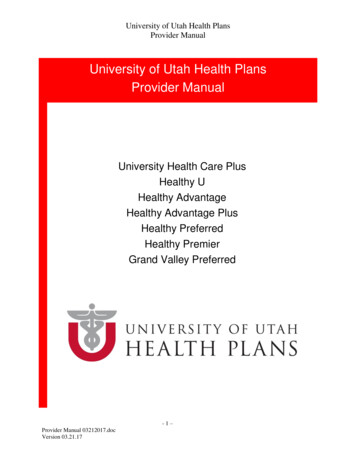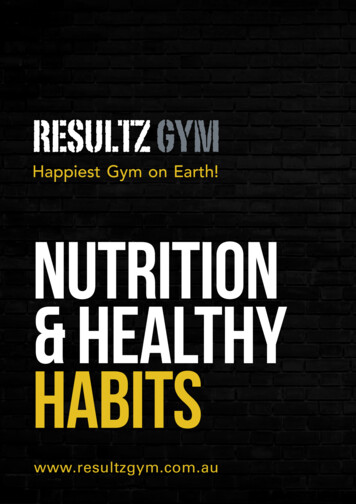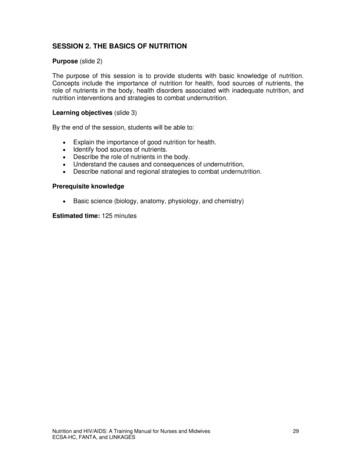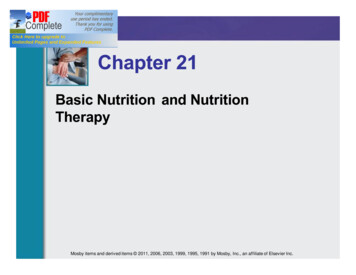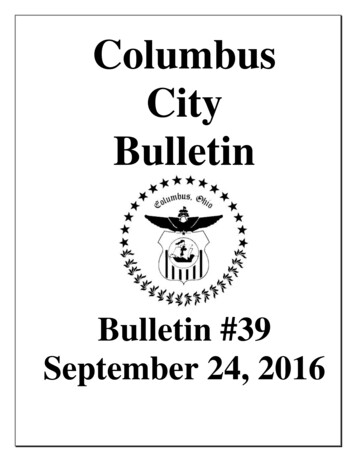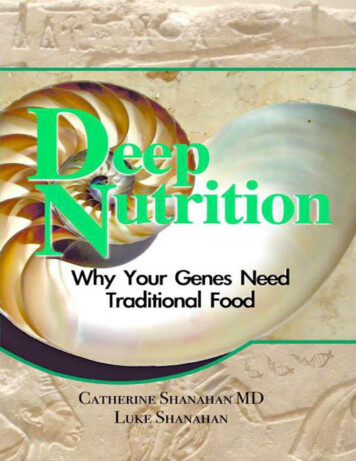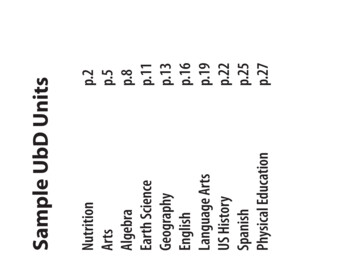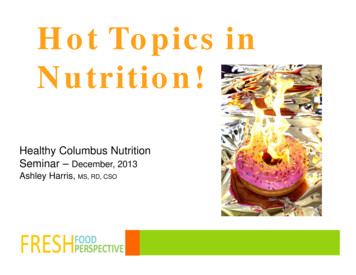
Transcription
Hot Topics inNutrition!Healthy Columbus NutritionSeminar – December, 2013Ashley Harris, MS, RD, CSO
Nutrition Hot Topics Diets – Fads & Myths Organics Gluten
Fad Diets
What is a fad? Webster’s defines a fad as “a short-lived fashion orcraze”So fad diets are short-lived, crazy diets!These diets do not work for many reasons – onereason being they are SHORT-LIVED
How to spot a fad diet Sounds too good to be true, it probably is, “Lose 15 lbs in 7days” Recommends using a single food on a very consistent basis Promises quick and easy weight loss with no effort Eliminates an entire food group (i.e. carbohydrates, dairy) Guarantees and outcome in a specified time period Bases evidence for effectiveness only on the quotes of otherdieters
DIETS GALORE!!
Fad Diet History 1820 – Vinegar & Water Diet 1825 – Low Carbohydrate Diet – “The Physiology of Taste” Jean Brillat-Savarin 1830 – Graham’s Diet 1863 – Banting’s Low Carbohydrate Diet (“banting” becomes popular term fordieting)1903 – Horace Fletcher promotes “Fletcherizin” (chew 32 times)1917 – Lulu Hunt Peters introduces calorie counting (in book Diet and Health, WithKey to the Calories) 1925 – Cigarette diet – “Reach for a Lucky instead of a sweet” 1928 – Inuit Meat-and-Fat Diet (Caribou, raw fish and whale blubber) 1930 – Hay Diet – Carbohydrates and proteins not allowed at same meal 1930 – Dr. Stoll’s Diet Aid (First of the liquid diet drinks) 1934 – Bananas & Skim Milk Diet (backed by the United Fruit Company)
Fad Diet History 1950 – Cabbage Soup Diet (flatulence is listed as main side effect) 1950 – Grapefruit Diet (Also known as “Hollywood Diet”) 1960 – Zen Macrobiotic Diet (Created by Japanese philosopher George Ohsawa) 1961 – Calories Don’t Count Diet – FDA filed charges regarding diet’s claim 1964 – Drinking Man’s Diet – Harvard School of Public Health declared dietunhealthful 1970 – Liquid Protein Diet (Liquid protein drinks were low in vitamins and minerals) 1976 – Sleeping Beauty Diet (Individual was heavily sedated for several days) 1981 – Beverly Hills Diet – only fruit for first 10 days, but in unlimited amounts 1985 – Fit for Life – Avoid combining protein and carbohydrate foods 1985 – Caveman Diet – Foods from the Paleolithic Era 1986 – Rotation Diet – Rotating number of calories taken in from week to week 1987 – Scarsdale Diet – Low-carbohydrate, low-calorie diet plan
Fad Diet History 1990 – Cabbage Soup Diet – Diet from 1950’s resurfaces on the web 1994 – High Protein, Low Carb Diet (Dr. Atkins’ version) 1995 – Sugar Busters – Cut Sugar to Trim Fat (eliminates refined carbohydrates) 1996 – Eat Right for Your Type – Diet based on blood type 1999 – Juice, Fasting and Detoxification 2000 – Raw Foods Diet (focuses on uncooked, unprocessed organic foods) 2001 – High Protein, Low Carb Diet (1994 diet updated) 2004 – Coconut Diet (replaces fat with coconut oil) 2005 – Cheater’s Diet (cheating on the weekends is required) 2006 – Maple Syrup Diet – Features a special syrup-lemon drink 2008 – Banana Diet – Bananas for breakfast, plus room-temperature water 2010 – Baby Food Diet – Basic plan: 14 jars of baby food a day, optional adult dinner 2012 – Wheat-free diet – Another version of a high-protein, low-carb diet
High Protein/Low Carb Low in calories and exclude grains and otherimportant high-carbohydrate foods Importantnutrients and fiber are being limited in the diet Higher in protein than recommended stress and injury tothe kidneys Some are also high in fat which can raise the risk ofdeveloping heart disease Majority of weight loss is muscle and water loss, soweight will be regained as soon as normal eatingresumes
Single Food Diets Only eat one food forseveral days Examples:the grapefruit diet,the rice diet, the cabbage soup diet Usually low in calories or get food fatigue and startconsuming lessVariety of foods not being eaten so nutrients aremissing from the diet
Blood Type Diets Eat foods based on your blood type Thinkingis that by eating certain foods, the body willprocess them more efficiently because they are for yourblood type Processing food more or less efficiently does not resultin weight lossEliminates foods and perhapsimportant nutrients
Liquid Diets Only consume liquids Somemay replace one or twomeals with liquids (i.e. Slim Fast, Optifast, juicing) Most provide few calories per day Claimto provide everything in a drink but they aremissing nutrients, fiber and phytochemicals that can onlybe found in food It is possible to consume just as many calories throughliquid as through food Maybe easier to consume more because food containsmore fiber that can help you feel full
Skipping Meals Premise is fewer meals result in fewer caloriesGoing several hours without eating will more thanlikely cause one to overeat when they have their nextmeal & slows metabolismIt is healthier for the body and appetite to eatregular meals when hunger strikes instead of skipping
Fasting (or close to it) Aka “crash dieting”Lacking in nutrients requiredfor normal functioning ofthe body Weight loss is a result of water and muscle loss Slows Metabolism Side effects include: extreme fatigue, constipation,nausea, diarrhea, and even gallstone formation
Detox Diets Several diets claim the body isfull of toxins which are stored inbody fat and need to be cleansed regularly to avoidillnessPlans include fasting, liquid dieting and/or use ofherbal teasNo scientific basis that supports this type of plan Substances store in mobilized body fat would reenter thebloodstream and be re-circulated through the liver and throughout thebody and would not necessarily be excreted or “flushed out”Need nutrients to support liver detoxification
Laxative Diets Belief that laxative use promotesweight lossLaxative-induced diarrhea does not significantlyreduce the number of calories absorbed from food Laxativesdo not work on the small intestine – wherecalories are absorbed, but on the colon Use can promote cramping, nausea, diarrhea,vomiting, constipation, dehydration, fainting, irregularheartbeat and electrolyte imbalances
Weight Loss Teas Several teas on the market: dieter’s tea, slim teas,fat-burning teas Likelycontain a form of a laxative but it may not belisted on the label If the tea contains: senna, aloe, rhubarb toor,buckthorn, cascara, or castor oil – it contains alaxativeUse can promote cramping, nausea, diarrhea,vomiting, constipation, dehydration, fainting, irregularheartbeat and electrolyte imbalances
Other Weight Loss Products Herbs, Hormones, Minerals MaHuang, DHEA (dehydroepian-drosterone), andindividual minerals like chromium are all marketed asweight loss aids Nonehave been proven to promote weight loss, buildmuscle, or anything beneficial MaHuang and DHEA havebeen found dangerous anddeaths have been linked toMa Huang!
More Skinny on the Fads . Avoid diets that claim the following: Rapid Weight Loss – Slow, steady weight loss is more likely to last thandramatic weight loss. If you lose more than ½ to 2 pounds per week youare likely losing muscle, bone and water. Quantities & Limitations – These usually work by either having you eata food in excess until you are sick of it or limiting certain foods. Both putyou are risk for missing critical nutrients. Specific Food Combinations – Zero evidence that certain foodcombinations or eating certain foods at certain times during the dayhelps lose weight or, as some claims say turn to fat immediately orproduce toxins in your intestines No Need to Exercise – Regular physical activity is essential for goodhealth and healthy weight management . The key is to find activities youenjoy and aim for 30 to 60 minutes of activity on most days of theweek.
Potential Health Problems Loss of energy – almost all fad diets call for lesscalories to promote quick weight loss When this happens, body tries to conserve energy by burningfewer calories, making you feel tiredDehydration- electrolytes sodium and potassium aredissolved in body waterWhen one is dehydrated, an imbalance of electrolytes occurscausing constipation, slowness of thought, labored breathing,dim vision, and can result in death Electrolytes conduct nerve transmissions and muscle contractions,including heart rhythm – an imbalance can cause cardiac arrest
Potential Health Problems Loss of muscle – when the body does not haveadequate energy it breaks down muscle for glucose Sourceof this glucose is mostly protein, or muscle tissue More muscle you have – the higher your metabolic rate By losing muscle- metabolic rate is slowed Muscle holds water so weight loss will actually beoccurring However, person is not losing fat and weight gain willoccur when old habits return Vitamin & Mineral Deficiencies – MANY!!!!!
Other Problems with Fad Diets False Hope – fad diets make promises they can’t keep byoffering “magic bullets”Feeling of failure – when the diet doesn’t work or the dietereats a forbidden food, he/she may feel failure or guiltLoss of Money- many products are expensiveAvoiding Real Change – by trying fad diets, person whoreally wants or needs to lose weight is avoiding making thechanges that will promote real weight loss for good
More Food Myths .
Other Myths .You should not eat after you workoutTheory: If you don't eat after workingout your body will continue to burnextra body fat
Other Myths .You should not eat after you workout Problem: Muscle and metabolism loss Exercise causes Glucose loss & muscledamage Not eating after working out may impairmuscle development
Eating after you workout Bottom Line: Eating carbohydrate/protein combinationwithin 3 hours after you workout Improves muscle recovery Improves muscleperformance May improve long termfat loss
Other Myths .If you don't eat fat, you can't get fat. Theory: Carbohydrates are for energy Protein is for muscle Fat is for fat Therefore if you don't eat fat, you can'tget fat
Other Myths .If you don't eat fat, you can't get fat Problem: Fat is essential Dietary fat is necessary for biological functions Essential fatty acids can't be made within thebody Some fats have shown health and body fatbenefits Olive oil Fish oil Nuts and seeds
Eating Fat Bottom line Fat is a necessary health nutrient withhealth benefits Any Nutrient which contains caloriescan be converted onto body fat Try to stick to health fats
Organics
Organics Refers to the way farmers grow and processagricultural productsDesigned to encouraged soil and waterconservation and reduce pollutionOrganic farmers: Don’tuse conventional methodsto fertilize, control weeds orprevent livestock disease
Organic Farming Apply natural fertilizers (i.e. manure, compost) to feed soil and plants Spray pesticides form natural sources Use beneficial insects and birds, mating disruption or traps to reducepests and disease Use environmentally-generated plant-killing compounds Rotate crops, till, hand weed or mulch to manage weeds Give animals organic feed and allow them access to the outdoors Use preventive measures (i.e. rotational grazing, balanced diet,clean housing) to help minimize disease
OrganicofDefinitionsLabelingorganic foods100 percent organic Exclusively produced using organicmethodsOrganic At least 95% of the ingredients (by weight, excludingwater and salt) in a processed product have been organicallyproduced. The remaining contents can only be natural orsynthetic ingredients allowed on the national list.Made with organic ingredients Produced with 70-95%organic ingredients, with up to three specific organicingredients or food groups listed on the front panel.Less than 70% organic ingredients Organicitems can only be listed in the ingredient panel, no mention oforganic on the main panel.
Organic Healthy
Things to Consider Environmental ImpactAnimal EthicsPesticide ResiduesNutritionCostTaste
Organics Better? Environmental Impact –YES (organic farming ismore environmentally sound)Animal Ethics – MOSTLY (organically farmedanimals given more outdoor access, usually treatedmore humanely)Pesticide Residue – MOSTLY (organic foods stillcontain pesticide residue, conventionally farmedfoods to not exceed government safety thresholds)
Organics Better? Nutrition - MAYBE (conflicting evidence thatorganics have more nutrients, more dependent onother factors such as soil, growing season, etc)Cost– NO (organic food typically more expensivethan conventional foods)Taste– MAYBE (depends on consumers taste &perceptions)
Things to Consider . Local foods are often organic and lessexpensive Farmers’ MarketsCommunity Supported Agriculture (CSA)programsLocal stands in groceryMay not be certified organic, but still goodEnvironmental Working Group lists “Dirty Dozen”“Clean 15”
Dirty Dozen - Clean 15
Gluten Free
Gluten Free Diets Necessary for people with Celiac Disease, glutenallergySome other conditions MAY be helped with glutenfree diet (i.e. Rheumatoid Arthritis)Evidence showing harm in diet not solid for generalpopulation Basedoff animal studies feeding rats high amounts of gluten Followpremise today’s wheat higher in gluten than in past
Gluten Free Diets Considerations Gluten-freeproductsusually more processed,higher in calories Glutenfound in MANY foods (i.e. beer, soy sauce, etc) Reductionin overall gluten intake may be beneficial butnot necessary to eliminate entirely Include Oats,etc.more gluten-free grains in diet!Rice, Quinoa, Amaranth, Buckwheat, Millet, Teff, Corn,
Questions?THANK YOU!!
Rapid Weight Loss – Slow, steady weight loss is more likely to last than dramatic weight loss. If you lose more than ½ to 2 pounds per week you are likely losing muscle, bone and water. Quantities & Limitations –These usually work by either having you eat a food in excess unt


